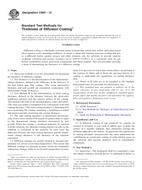Potrebujeme váš súhlas na využitie jednotlivých dát, aby sa vám okrem iného mohli ukazovať informácie týkajúce sa vašich záujmov. Súhlas udelíte kliknutím na tlačidlo „OK“.
ASTM C664-10
Standard Test Methods for Thickness of Diffusion Coating
Automaticky preložený názov:
Štandardné skúšobné metódy pre Hrúbka Diffusion Coating
NORMA vydaná dňa 1.4.2010
Informácie o norme:
Označenie normy: ASTM C664-10
Poznámka: NEPLATNÁ
Dátum vydania normy: 1.4.2010
Kód tovaru: NS-14506
Počet strán: 3
Približná hmotnosť: 9 g (0.02 libier)
Krajina: Americká technická norma
Kategória: Technické normy ASTM
Anotácia textu normy ASTM C664-10 :
Keywords:
Diffusion coatings, Coating thickness, Electroplated coatings, Microscopic examination--metallic/inorganic coatings, Thickness--electrodeposited coatings, ICS Number Code 17.040.20 (Properties of surfaces)
Doplňujúce informácie
| Significance and Use | ||||
|
A diffusion coating is one produced by causing an element or elements to react with or diffuse into, or both, the surface of a metallic substrate, thus chemically altering the substrate adjacent to the surface. To appreciate the significance of coating thickness measurements one must understand the contributions to a particular coating of solid-solution zones in the substrate and reaction products such as intermetallic compounds. |
||||
| 1. Scope | ||||
|
1.1 These test methods cover two procedures for measuring the thickness of diffusion coatings. 1.2 Test Method A is the determination of the dimensional-change thickness, defined as the difference in the thickness of the part before and after coating. (The terms micrometer thickness and part growth are considered synonymous with dimensional change thickness.) 1.3 Test Method B is the determination of total coating thickness, defined as the distance between the observably unaffected substrate and the exterior surface of the coating. This includes the total of all included phases, zones and layers. (The term case depth is considered to be synonymous with total coating thickness.) The total coating thickness is determined by cross-sectioning the coating, preparing a metallurgical mount and microscopically measuring the coating thickness. 1.4 The total coating thickness as determined microscopically from a cross-section will usually be greater than, or equal to, the dimensional change thickness determined by part growth. When the coating is produced primarily by reaction with the substrate, the substrate-coating interface recedes as the substrate is consumed in the reaction. In such cases the difference between the total coating thickness and the dimensional change thickness is the thickness of the substrate consumed. 1.5 Diffusion coatings are usually formed at elevated temperatures for service at elevated temperatures. This means that diffusion coatings are dynamic systems which are continually undergoing changes while in an elevated-temperature environment. It is necessary to know that certain phases are growing at the expense of others and to know the previous history of a coating to understand the significance of coating thickness data. 1.6 Values in SI units are to be regarded as the standard. Inch-pound units are provided for information only. 1.7 This standard does not purport to address all of the safety concerns, if any, associated with its use. It is the responsibility of the user of this standard to establish appropriate safety and health practices and determine the applicability of regulatory limitations prior to use. |
||||
| 2. Referenced Documents | ||||
|




 Cookies
Cookies
